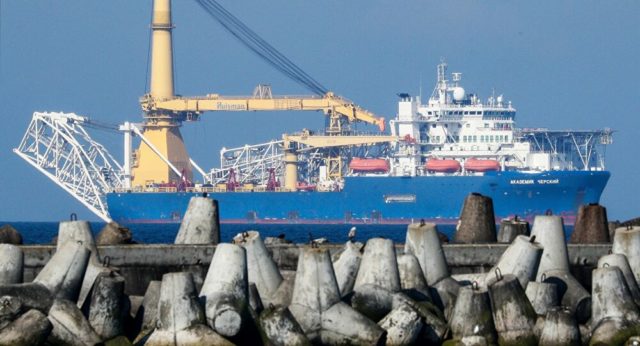
Can the Vessel Akademik Cherskiy Finish Nord Stream Two Pipeline Construction?
Publication: Eurasia Daily Monitor Volume: 17 Issue: 143
By:

At the beginning of October 2020, the Akademik Cherskiy—the only Russian pipe-laying ship capable of completing the construction of the Nord Stream Two natural gas pipeline—began its sea trials following five-month-long upgrades at the German port of Mukran. According to reports, the current phase of tests should end before the end of the month; and if everything goes as planned, the Cherskiy may start pipe-laying operations as soon as November–December of this year (Biznesalert.pl, September 29). The latest development, however, do not bring the Nord Stream Two saga to an end quite yet, as United States sanctions may still thwart the controversial Russian pipeline project in the coming months.
Nord Stream Two, a dual-string, 1,200-kilometer mainly undersea pipeline is designed to carry an additional 55 billion cubic meters of Russian gas per year directly to Germany (doubling the capacity of the already-existing Nord Stream One), bypassing the main transit pipelines leading into Europe through Ukraine and, to a lesser extent, Belarus. Since the halt of Nord Stream Two construction in December 2019, the project’s status has effectively remained unchanged: around 95 percent of the pipes have been laid along the bottom of the Baltic Sea, and the only portion left to be finished is a 160 km offshore section in the Danish and German exclusive economic zones (EEZ). Had US sanctions not been introduced last winter, this short fragment could have been completed in a matter of a few weeks since the previous contractor, the Swiss-Dutch Allseas, was at that point able to use two advanced vessels simultaneously, laying altogether as much as 9–10 km of pipes per day. Russian capabilities in this regard, on the other hand, are significantly more limited.

First of all, the Akademik Cherskiy will, in all likelihood, have to work alone. The second Russian pipe-laying vessel assigned to the project, the Fortuna (which is, in fact, not a proper ship, but a 12-point anchor barge), will not be able to join the full-time construction operations in the winter conditions due to technical limitations (Esperis.pl, August 2019). Possibly, the Fortuna may ultimately be deployed to help with some specific parts of the work, such as above-water tie-in performance (Nord-stream2.com, August 2020), but it will have a rather minor impact on the general pace of pipe-laying.
Moreover, the Akademik Cherskiy will not be able to provide the same, top-class speed of pipe-laying like Allseas’ vessels could showcase. Rather, the Cherskiy will probably not be able to lay more than about 3 km of pipe per day, and that velocity would be even further reduced if the vessel cannot use its Dynamic Positioning system but has to be positioned with anchors instead. Last but not least, it is worth remembering that during winter, the Russians will have to periodically halt pipe-laying operations for a few days because of poor weather conditions (as was also the case last December, when Allseas ships were working in Danish waters).
All things considered, even if the Russian side can manage to restart Nord Stream Two construction in the coming months, they will still need some time to finally complete the project. More than likely, the pipe-laying works alone will require at least two months, and they will then have to be followed up by other types of activities, including rock placement, post-lay surveys, commissioning, etc. (Ens.dk, April 2019). Therefore, a realistic estimate suggests it will take no fewer than 4–5 months from the possible deployment of the Akademik Cherskiy at the “construction site” until Russian natural gas can finally begin to flow through the completed Nord Stream Two pipeline.
All that said, the above-presented Russian plans for Nord Stream Two’s completion could still be derailed should a new US sanctions package be adopted by Congress in the coming months. One of the options in that regard is the extension of the Protecting Europe’s Energy Security Act (PEESA), enacted in December 2019, which resulted in the past year’s halt in Nord Stream Two construction works. The extension of PEESA is included in the bill text of the National Defense Authorization Act for the Fiscal Year 2021 (NDAA FY2021), which is expected to be passed sometime after the US presidential election (USNI News, September 9).
At the moment, there are two slightly different wordings of the PEESA Clarification Act (within the NDAA FY2021 bill) proposed by each chamber of Congress that remain to be adjusted. The main distinction between the two versions is actually of crucial importance: while the Senate has proposed to sanction entities providing certification services to Nord Stream Two, the House of Representatives skipped that very provision. The final outcome of the reconciliation of the two versions of the bill may be decisive for Nord Stream Two’s ultimate fate.
Only a small handful of companies in the world exist that can certify an offshore pipeline like Nord Stream Two’s conformity with legal regulations. One of those is Norwegian Det Norske Veritas (DNV), which the pipeline consortium operator Nord Stream 2 AG already appointed a few years ago to provide the needed independent verification and certification services (Nord-stream2.com, September 2016). If US sanctions force DNV to leave the project, as Allseas did back in 2019, it will be extremely difficult for Russia to replace the Norwegian firm—particularly since Nord Stream Two is already being built according to DNV norms and standards.



